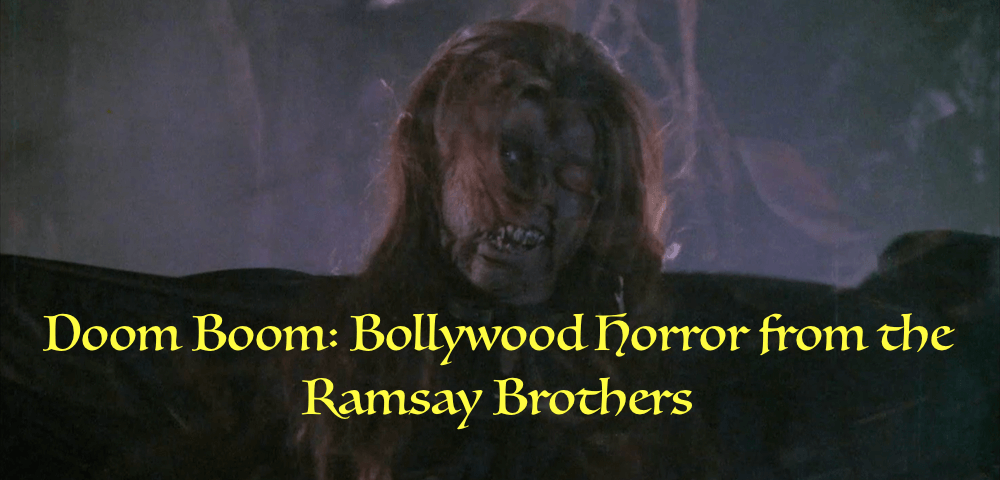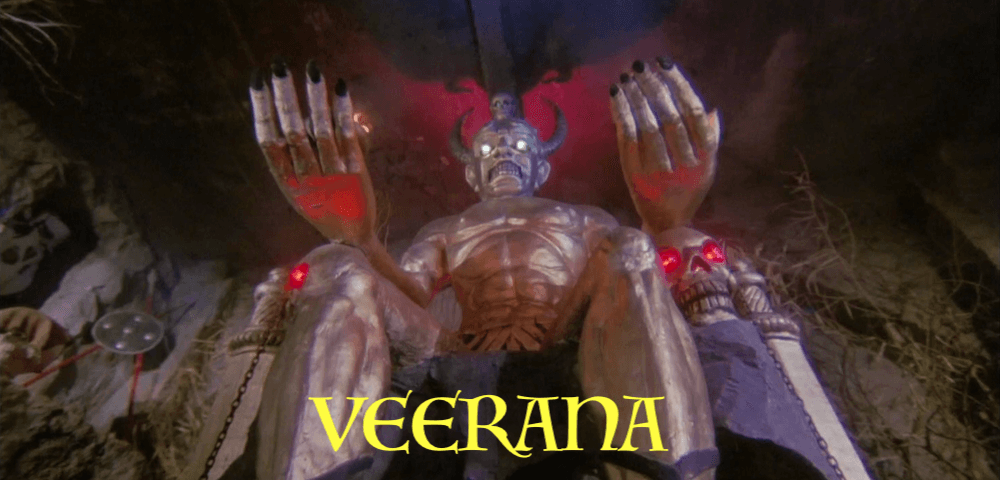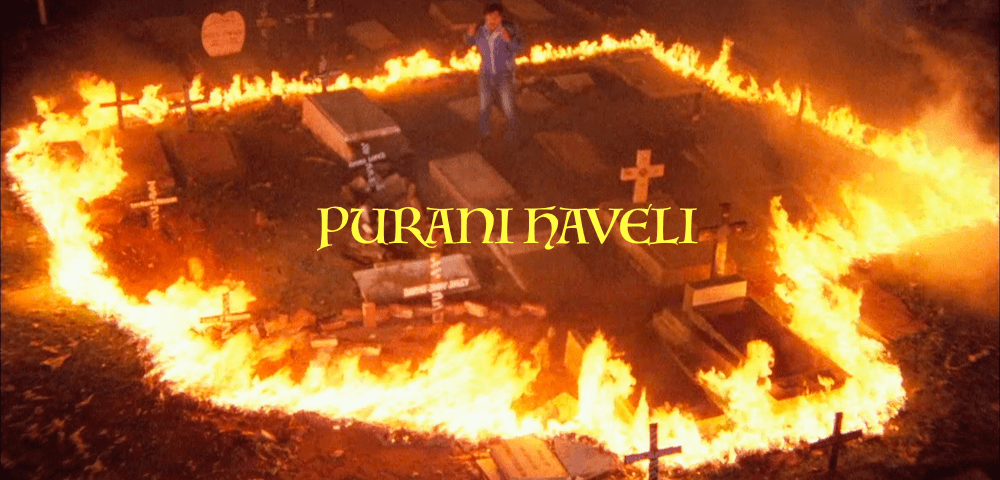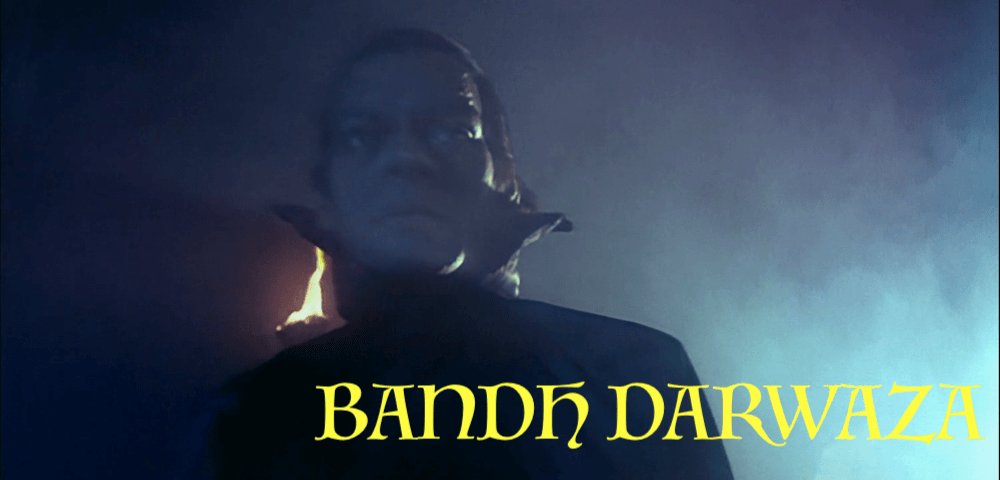
Like transmissions from another planet: re-animated ghosts and/or corpses stalk swimsuit-clad women (usually wearing one-pieces) and their singing paramours. The most familiar parts of these movies resemble (and are, uh, directly influenced by) American horror movies like The Exorcist, The Omen, The Evil Dead, and A Nightmare on Elm Street. But only parts: Doom Boom horror movies are mostly concerned with romantic angst, shirtless he-man punching, and cross-generational, parents-just-don’t-understand miscommunication. Eventually, shaman-like tantriks are called in to vanquish hulking vampire/zombie-types with big foreheads and splotchy monster make-up. And then everybody gets married and/or respects their elders. — Simon Abrams, Fangoria
Every Ramsay movie ends with the monster exploding. Every single one. — Grady Hendrix, Film Comment
The history of horror in Indian cinema hinges on a single scene in 1970’s EK NANHI MUNI LADKI THI, a box office bomb produced by Mumbai electronics shop owner turned would-be film impresario F.U. Ramsay. When his sons Tulsi and Shyam visited the theater where the film was playing, they noticed something weird: Throngs of audience members would pay the ushers a handful of change to be let into the empty auditorium to watch one specific scene. In it, star Prithviraj Kapoor breaks into a museum, protected by armor and disguised by a grotesque mask and black cape. He looks “just like Dracula,” Tulsi recalled in a 2012 interview, and his armor repels police bullets, making him unkillable, “like a ghost. A monster.”
And so it was that the seven Ramsay brothers, already admirers of the likes of Hammer productions, trained themselves as filmmakers and founded a horror empire. Ramsay movies were very much a family affair. Tulsi and Shyam directed from Kumar’s scripts, Kiran recorded the sound, Keshu designed the lighting, Gangu served as cinematographer, Arjun edited, and their mother Kishni and their wives did makeup and craft services.
Beginning with India’s first zombie movie, DO GAZ ZAMEEN KE NEECHE (1972), Ramsay films were popular with rural audiences, similar to the regional success of many independent and low-budget horror films in America during the pre-multiplex days. PURANA MANDIR was the second-highest-grossing Indian film of 1984, sparking a host of copycats, the so-called “Doom Boom.” This both cemented horror’s place in Bollywood history and risked oversaturation, especially for a genre considered low-rent and disreputable by higher-caste urban audiences and the industry elite. “No stars, no cars” was a Ramsay refrain — their casts of inexperienced ingenues and weathered B-movie hams got to set by bus and often wore their own clothes, which tended to preppy sportswear.
These films were, to say the least, resourceful. The Ramsays picked locations (not infrequently recycled between productions) that took advantage of the landscape of rural Mahabaleshwar, with its ruined colonial-era villas, creepy woods, and dungeon sets dressed up with cobwebs, taxidermied animal heads, and random/scary wall art. Interesting camera angles, lighting gels, and smoke machines made low-cost contributions to a supernatural Bava-esque atmosphere.
The films draw from universal horror grammar. Characters sport awesomely ’80s chest thatches and blowouts, and they make terrible, terrible decisions. Plots and creatures were aggressively ripped off from classic and contemporary American creature features, from coffin-dwelling vampires to girls glowing with the sickly aura of demonic possession, with a locally specific emphasis on marriage plots and family-first morals. The monster dwelling in an old house stood an equal chance of being vanquished by a crucifix or an om. These films invariably boast a classic masala mix of song and dance, broad and often offensive comic relief, amateur fight scenes, and (almost entirely chaste) romance. More campy than scary, the Ramsays’ best films are nevertheless inspiring for their craft, imagination, and enthusiasm — all on crystal-clear display in the 2023 digital restorations by Pete Tombs for a Mondo Macabro Blu-Ray release.
Programmed in collaboration with Simon Abrams.

VEERANA
(Deserted Place)
dir. Shyam and Tulsi Ramsay, 1988
India, 140 mins
In Hindi with English subs
SATURDAY, MARCH 1 – MIDNIGHT
MONDAY, MARCH 10 – 7 PM
TUESDAY, MARCH 25 – 10 PM
A “uniquely surreal possession movie” (Grady Hendrix, Film Comment) starring the model Jasmin in her only significant film role as a young woman possessed by a seductress demon who (in a typical Ramsay touch) is introduced and vanquished in the pre-credits sequence before returning to torment a new generation. Perhaps the pinnacle of the Ramsays’ art, Veerana features their groddiest monster makeup and most sinister servants, with setpieces drawing alternately from arcane religious superstition and meta-modern references to horror masters like Hitchcock (comically) and Hooper (plagiaristically).

PURANI HAVELI
(The Old Mansion)
dir. Shyam and Tulsi Ramsay, 1989
India, 145 mins
In Hindi with English subs
TUESDAY, MARCH 4 – 10 PM
THURSDAY, MARCH 13 – 7 PM
SATURDAY, MARCH 22 – 10 PM
Anita, whose parents were killed when they stopped for a quickie in an abandoned mansion, is all grown up and wants to marry lowly fashion photographer Sunil. But her auntie and uncle have a plan to steal her inheritance that involves moving her and her entire entourage into a haunted house — by coincidence, the very one where her parents died. Anita, her suitors, and her gal pals are duly menaced by terrifying visions of a hairy beast who lives in the basement, a menacing but extremely slow-moving suit of armor that no one seems able to simply run away from, and a strange old man who wanders the grounds moaning dire warnings that everyone mostly ignores (even after their peers have started to die mysteriously). Plus: A subplot about a dangerous and romantic bandit king (and lover of Donna Summer) who bears a striking resemblance to the crew’s portly homophobic servant.

BANDH DARWAZA
(Closed Door)
dir. Shyam and Tulsi Ramsay, 1990
India, 145 mins
In Hindi with English subs
SUNDAY, MARCH 2 – 5 PM
FRIDAY, MARCH 7 – MIDNIGHT
TUESDAY, MARCH 11 – 10 PM
TUESDAY, MARCH 18 – 10 PM
In their 1984 breakthrough hit PURANA MANDIR, the Ramsays found their monster in Anirudh Agarwal, a six-foot-five civil engineer with a pituitary tumor and a face seemingly carved out of granite. “They didn’t even need to put make-up on me,” he would reflect to the BBC. Agarwal returns here for his other great Ramsay monster role: a caped and fanged bat demon fed a steady diet of maidens by a coven of familiars. Like all Dracula stories, BANDH DARWAZA is a meditation on taboo desire and repression, much of it given over to a love triangle between a temptress (promised to the demon before her conception by her infertile mother) and the couple she tries to come between, even intruding on their love duets.
